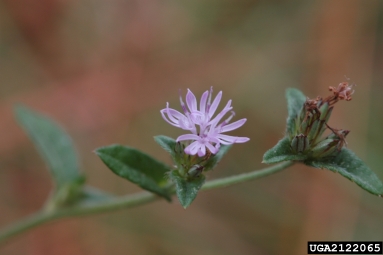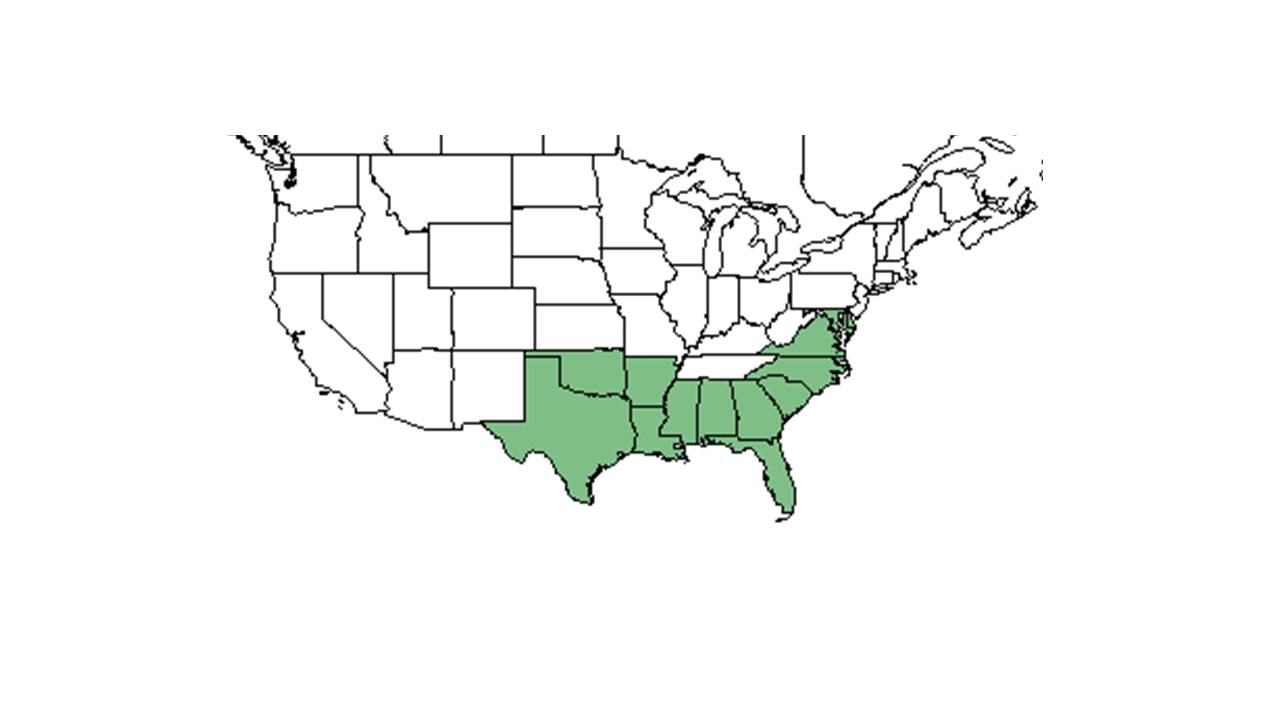Difference between revisions of "Elephantopus nudatus"
(→Distribution) |
|||
| (One intermediate revision by the same user not shown) | |||
| Line 33: | Line 33: | ||
==Ecology== | ==Ecology== | ||
===Habitat=== <!--Natural communities, human disturbed habitats, topography, hydrology, soils, light, fire regime requirements for removal of competition, etc.--> | ===Habitat=== <!--Natural communities, human disturbed habitats, topography, hydrology, soils, light, fire regime requirements for removal of competition, etc.--> | ||
| − | Generally, ''E. nudatus'' can be found in usually fairly dry woodlands and woodland borders.<ref name= | + | Generally, ''E. nudatus'' can be found in usually fairly dry woodlands and woodland borders.<ref name=weakley/> It is found in edges of swamps, creek bottomlands, hammocks, Longleaf pine-wiregrass savannas, edges of deciduous forests, open pine flatwoods, boggy bottomlands, in wooded area above floodplains and in floodplains, in mesic flatwoods, and edges of ponds. Is also found in human disturbed areas such as along the roadside, flatwoods that have been clear cut, and in lawn adjacent to parking lot area. Can thrive in areas of low light or high light levels. Is associated with moist, loamy sand; fine, sandy soils; alluvial sands; and loamy humus soil types.<ref name=fsu>Florida State University Robert K. Godfrey Herbarium database. URL: http://herbarium.bio.fsu.edu. Last accessed: June 2014. Collectors: Loran C. Anderson, D. B. Ward, Robert K. Godfrey, R. D. Houk, D. B. Ward, S. S. Ward, Jean W. Wooten, R. Kral, Almut G. Jones, R. A. Norris, R. Komarek, and Cecil R Slaughter. States and Counties: Florida: Baker, Escambia, Franklin, Gadsden, Gulf, Hamilton, Jefferson, Leon, Liberty, Marion, Nassau, Putnam, Santa Rosa, St Johns, Union, Wakulla, and Walton. Georgia: Grady and Thomas.</ref> As well, it is listed as a facultative species by the USDA Natural Resources Conservation Service, where it can occur in both wetland and non-wetland habitats.<ref>USDA, NRCS. (2016). The PLANTS Database (http://plants.usda.gov, 6 May 2019). National Plant Data Team, Greensboro, NC 27401-4901 USA.</ref> In Florida, ''E. nudatus'' is considered an indicator species of the upper panhandle savannas community.<ref>Carr, S. C., et al. (2010). "A Vegetation Classification of Fire-Dependent Pinelands of Florida." Castanea 75(2): 153-189.</ref> |
Associated species include ''Chasmanthium sessiliflorum, Cyperus tetragonus, Panicum hamitomon, Bacopa.'' <ref name=fsu/> | Associated species include ''Chasmanthium sessiliflorum, Cyperus tetragonus, Panicum hamitomon, Bacopa.'' <ref name=fsu/> | ||
| Line 40: | Line 40: | ||
===Phenology=== <!--Timing off flowering, fruiting, seed dispersal, and environmental triggers. Cite PanFlora website if appropriate: http://www.gilnelson.com/PanFlora/ --> | ===Phenology=== <!--Timing off flowering, fruiting, seed dispersal, and environmental triggers. Cite PanFlora website if appropriate: http://www.gilnelson.com/PanFlora/ --> | ||
| − | This species generally flowers from late July until September.<ref name= | + | This species generally flowers from late July until September.<ref name=weakley/> ''E. nudatus'' has been observed flowering in September and October.<ref name=fsu/><ref>Nelson, G. [http://www.gilnelson.com/ PanFlora]: Plant data for the eastern United States with emphasis on the Southeastern Coastal Plains, Florida, and the Florida Panhandle. www.gilnelson.com/PanFlora/ Accessed: JULY 2015</ref> |
<!--===Seed dispersal===--> | <!--===Seed dispersal===--> | ||
<!--===Seed bank and germination===--> | <!--===Seed bank and germination===--> | ||
Latest revision as of 12:50, 26 May 2023
| Elephantopus nudatus | |
|---|---|

| |
| Photo by Chris Evans, University of Illinois, Bugwood.org | |
| Scientific classification | |
| Kingdom: | Plantae |
| Division: | Magnoliophyta - Flowering plants |
| Class: | Magnoliopsida – Dicotyledons |
| Order: | Asterales |
| Family: | Asteraceae ⁄ Compositae |
| Genus: | Elephantopus |
| Species: | E. nudatus |
| Binomial name | |
| Elephantopus nudatus A. Gray | |

| |
| Natural range of Elephantopus nudatus from USDA NRCS Plants Database. | |
Common name(s): smooth elephantsfoot; coastal plain elephant's-foot
Contents
Taxonomic notes
Synonyms: none[1]
Varieties: none[1]
Description
A description of Elephantopus nudatus is provided in The Flora of North America. While the fruit of this species if often referred to as an achene, it is a cypsela.[2]
Distribution
This species is distributed along the southeastern Coastal Plain from Delaware south to north peninsular Florida, and west to eastern Texas as well as Arkansas. It is also native south of the United States to northern South America.[1]
Ecology
Habitat
Generally, E. nudatus can be found in usually fairly dry woodlands and woodland borders.[1] It is found in edges of swamps, creek bottomlands, hammocks, Longleaf pine-wiregrass savannas, edges of deciduous forests, open pine flatwoods, boggy bottomlands, in wooded area above floodplains and in floodplains, in mesic flatwoods, and edges of ponds. Is also found in human disturbed areas such as along the roadside, flatwoods that have been clear cut, and in lawn adjacent to parking lot area. Can thrive in areas of low light or high light levels. Is associated with moist, loamy sand; fine, sandy soils; alluvial sands; and loamy humus soil types.[3] As well, it is listed as a facultative species by the USDA Natural Resources Conservation Service, where it can occur in both wetland and non-wetland habitats.[4] In Florida, E. nudatus is considered an indicator species of the upper panhandle savannas community.[5]
Associated species include Chasmanthium sessiliflorum, Cyperus tetragonus, Panicum hamitomon, Bacopa. [3]
Elephantopus nudatus is an indicator species for the Upper Panhandle Savannas community type as described in Carr et al. (2010).[6]
Phenology
This species generally flowers from late July until September.[1] E. nudatus has been observed flowering in September and October.[3][7]
Fire ecology
A study in north Florida found this species to increase in foliage biomass in response to fire as well as other disturbance like clearcutting, shearing and piling, bedding, discing, and stump removal.[8]
Conservation, cultivation, and restoration
Cultural use
Photo Gallery
References and notes
- ↑ 1.0 1.1 1.2 1.3 1.4 Weakley, A.S. 2020. Flora of the Southeastern United States. Edition of 20 October 2020. University of North Carolina at Chapel Hill, Chapel Hill, North Carolina.
- ↑ [[1]] Lady Bird Johnson Wildflower Center. Accessed: May 6, 2019
- ↑ 3.0 3.1 3.2 Florida State University Robert K. Godfrey Herbarium database. URL: http://herbarium.bio.fsu.edu. Last accessed: June 2014. Collectors: Loran C. Anderson, D. B. Ward, Robert K. Godfrey, R. D. Houk, D. B. Ward, S. S. Ward, Jean W. Wooten, R. Kral, Almut G. Jones, R. A. Norris, R. Komarek, and Cecil R Slaughter. States and Counties: Florida: Baker, Escambia, Franklin, Gadsden, Gulf, Hamilton, Jefferson, Leon, Liberty, Marion, Nassau, Putnam, Santa Rosa, St Johns, Union, Wakulla, and Walton. Georgia: Grady and Thomas.
- ↑ USDA, NRCS. (2016). The PLANTS Database (http://plants.usda.gov, 6 May 2019). National Plant Data Team, Greensboro, NC 27401-4901 USA.
- ↑ Carr, S. C., et al. (2010). "A Vegetation Classification of Fire-Dependent Pinelands of Florida." Castanea 75(2): 153-189.
- ↑ Carr, S.C., K.M. Robertson, and R.K. Peet. 2010. A vegetation classification of fire-dependent pinelands of Florida. Castanea 75:153-189.
- ↑ Nelson, G. PanFlora: Plant data for the eastern United States with emphasis on the Southeastern Coastal Plains, Florida, and the Florida Panhandle. www.gilnelson.com/PanFlora/ Accessed: JULY 2015
- ↑ Conde, L. F., et al. (1983). "Plant species cover, frequency, and biomass: Early responses to clearcutting, burning, windrowing, discing, and bedding in Pinus elliottii flatwoods." Forest Ecology and Management 6: 319-331.